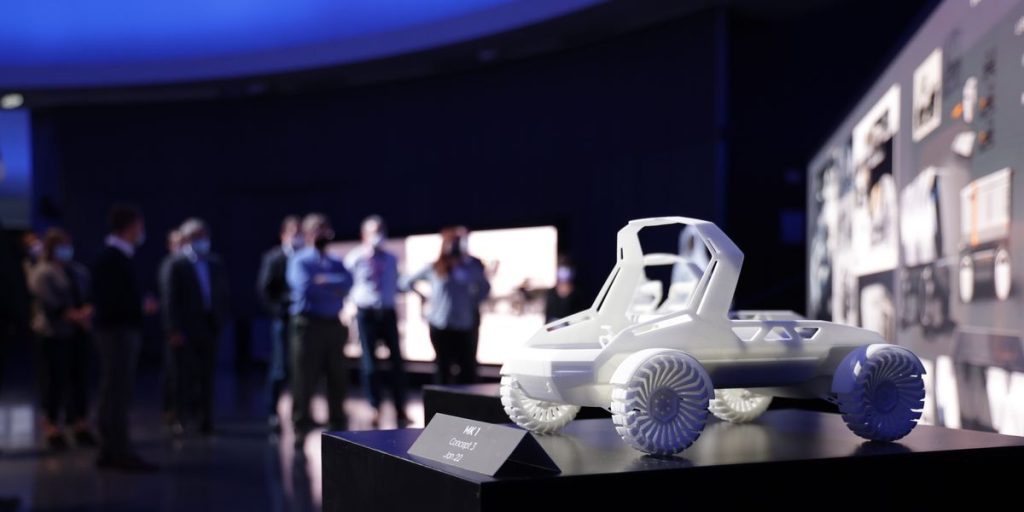Lunar Moon Rover Is GM and Lockheed Martin's Moonshot

Development of General Motors and Lockheed Martin’s Lunar Mobility Vehicle (LMV) is underway, and the two companies intend to deliver the first of these vehicles by the middle of the decade. As its name suggests, the LMV is a moon-bound vehicle that may play a part in the National Aeronautics and Space Administration’s (NASA’s) upcoming Artemis mission that intends to bring humankind back to the Earth’s lone satellite more than 50 years after the conclusion of the Apollo missions.
That said, there are no guarantees this jointly developed lunar vehicle will win NASA’s contract and make the trip. As of this writing, NASA has released a Request for Information (RFI) for what it calls a Lunar Terrain Vehicle (LTV) for the mission. The American space agency intends to release a Request for Proposal (RFP) before year’s end, at which point vendors, such as GM and Lockheed Martin, can submit business proposals for the project, with NASA later awarding one of these vendors the contract. Regardless of the outcome, GM and Lockheed Martin are prepared to build and produce the LMV with or without government funding.
“[This is] a vehicle developed 100 percent for industry,” Derek Hodgins of Lockheed Martin said during a media event at GM’s Milford Proving Ground in Michigan. The two American corporations brought us here to pull back the curtain on the development process of the commercial-use LMV.
DIL-y DIL-y
Testing such a vehicle on our planet, however, is a difficult task given the differences between the Earth’s and moon’s environments, the latter of which includes large craters, an approximate temperature swing of 500 degrees Fahrenheit, and a gravitational pull that’s around one-sixth of the blue marble we call home. So, GM created a digital lunar surface using data supplied by Lockheed Martin. The automaker then feeds this information into its Driver-in-the-Loop (DIL) simulator at the Milford Proving Ground.
Though the DIL is an essential component to the development of the LMV, its use spans multiple projects. In fact, the DIL was key to the short development time of the GMC Hummer EV, which went from idea to complete vehicle in about two years—approximately half the time it typically takes GM to complete this process.
Credit the relative ease by which GM engineers can alter vehicle dynamics using the DIL. Is the virtual vehicle displaying too much body roll or is far too eager to whip its tail out mid-corner? All it takes is a few tweaks to the dataset to adjust the dynamic characteristics of the vehicle’s suspension system.
GM refrained from sharing the cost of the DIL with us; however, a company spokesperson informed us the DIL has more than paid for itself in tire and fuel savings alone—items the automaker pays for when a vehicle undergoes real-world development tests. This isn’t to say the DIL is a replacement for such testing. Rather, the setup allows GM engineers to focus on developing more promising dynamic profiles (and cull less favorable ones) for a given vehicle when the time comes to test it in real-world environments.
Given the 238,355 miles that—on average—separates the Earth and the moon, the first LMV’s dynamic development is due to rely heavily on information gleaned from the DIL. In order to better understand this process, GM and Lockheed Martin gave us a chance to wander about the DIL’s virtual lunar landscape in a digital LMV.
Whereas the production LMV will incorporate hand controls, as on the lunar rover of the later Apollo missions, the DIL’s cockpit included a steering wheel and brake and accelerator pedals for steering, stopping, and accelerating the virtual LMV. Similarly, the tweel-like tires on the digital vehicle are not anticipated to reach the finished product. Instead, the LMV is set to wear mesh-like tires reminiscent of those of the Apollo missions’ lunar rovers. This sort of tire design is less likely to stir up any of the razor-sharp and adhesive dust that sits on the moon’s surface.
Although the LMV’s operating speed is expected to average 5 mph, the virtual vehicle GM and Lockheed Martin uploaded to the DIL topped out at approximately 12.5 mph—a harrowing speed to drive in a low-gravity atmosphere on rocky and crater-filled surfaces. Frankly, we wish we had more to share about driving this virtual vehicle in this digitally produced lunar landscape, however, we were unable to fight off motion sickness while operating the theme park simulator ride–like DIL (something we warned about prior to entering the DIL’s cockpit). Though we spent the entirety of our allotted time making the most of the power produced by the LMV’s four electric motors (the total output of which was simply described as “low” by a GM spokesperson), our queasiness prevented us from fully appreciating or assessing the LMV’s driving experience.
Industry Baby
GM and Lockheed Martin foresee the LMV as a mostly autonomous vehicle, with humans occupying the control stick approximately one week out of the year. The goal is to have the vehicle drive itself with minimal oversight, with the program’s chief engineer, Brent Deep, stating the LMV’s autonomous capabilities will build on the knowledge gleaned from Cruise’s self-driving vehicle technology and GM’s Super Cruise and Ultra Cruise hands-free driver-assist systems.
Likewise, the LMV will power its motors by way of a battery pack much like the so-called Ultium units GM fits within the likes of the GMC Hummer EV and upcoming Cadillac Lyriq. Among the differences between the LMV’s battery pack and those GM puts in its passenger vehicles: The lunar vehicle’s pack relies on cylindrical cells, as opposed to pouch-style ones. According to Deep, the cylindrical cells are better at coping with the moon’s vast temperature swings.
GM and Lockheed Martin intend for the LMV to have a long service life, with the two companies expecting to bring multiple variants of the vehicle to the moon as a means of maximizing the project’s commercial viability. “We don’t have a disposable rover,” Deep said.
If all goes according to plan, space agencies—and maybe even wealthy adventurers—throughout the world will pay to use GM and Lockheed Martin’s co-developed LMVs during lunar missions—or simply for kicks.
This content is created and maintained by a third party, and imported onto this page to help users provide their email addresses. You may be able to find more information about this and similar content at piano.io




